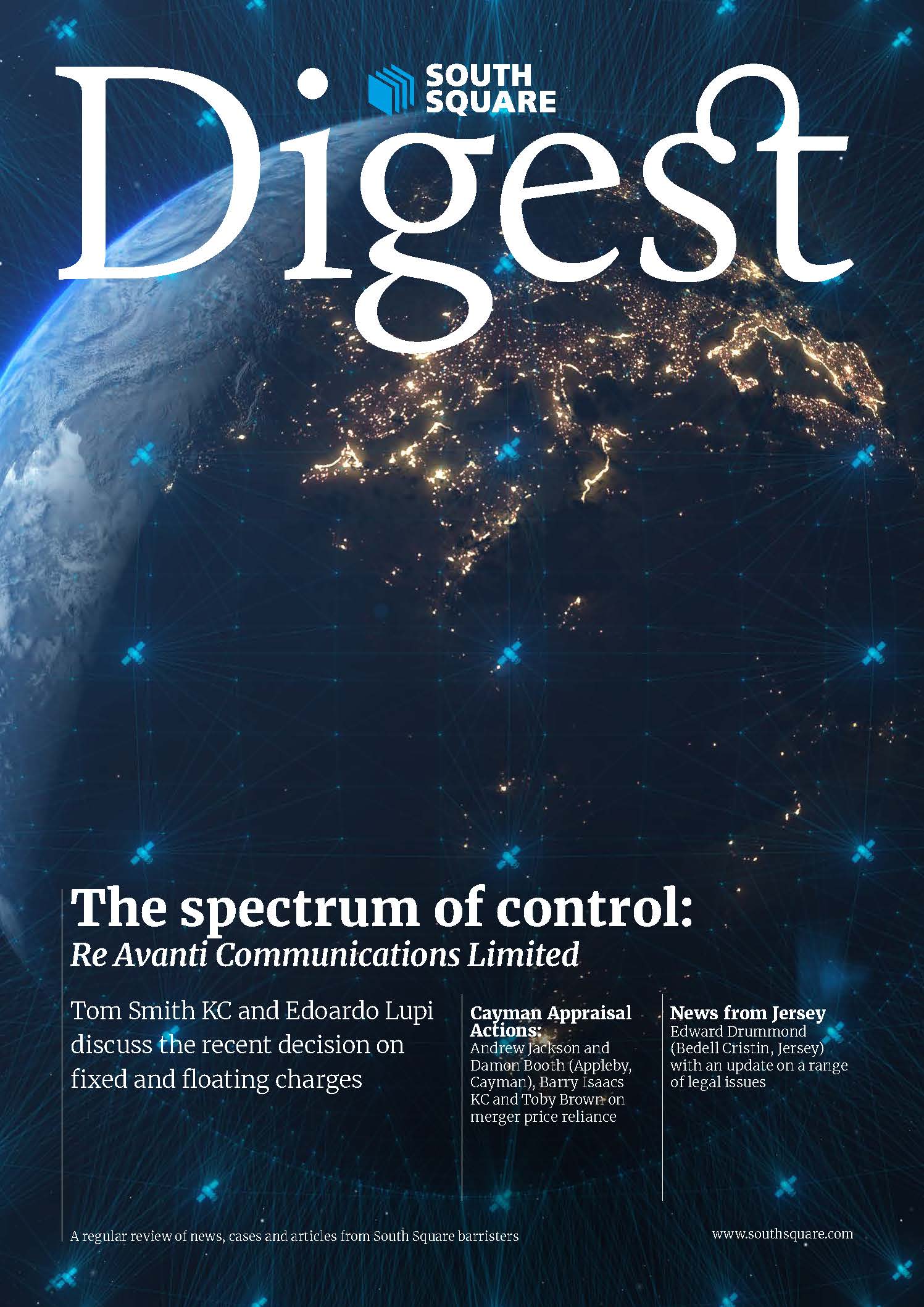

BY Peter Burgess
Introduction
When the Corporate Insolvency and Governance Act 2020 (“CIGA”) came into force on 26 June 2020, it was the most significant change to the UK’s corporate insolvency regime in 20 years. As well as the temporary measures designed to mitigate the impacts of the Covid-19 pandemic, it introduced three permanent measures: (a) Restructuring Plans (“RPs”); (b) the Part A1 moratorium; and (c) the insertion of section 233B and Schedule 4ZZA into the Insolvency Act 1986 (“Suspension of Termination (ipso facto) Clauses” or “SoTC”).
During the passage of the bill that became CIGA, the Government committed to review the three permanent measures no later than three years after they came into force. As a result, in June 2023, the Insolvency Service published its “Post Implementation Review” (“PIR”) into CIGA.
Summary
The PIR concluded that the permanent CIGA measures had been broadly welcomed and seen as a positive addition to the UK’s rescue framework, although usage had been lower than expected; official statistics indicate that as at 30 September 2022, there had been only 40 moratoria and 12 RPs since the introduction of CIGA on 26 June 2020. The PIR suggested that the Government’s extensive support provided during the pandemic meant that the market has not returned to pre-pandemic levels and that it may take time for industry to adopt new measures.
The PIR was primarily based on an evaluation undertaken by the University of Wolverhampton, which focused on how the measures are working and if they are worked as expected. It also made use of semi-structured interviews with stakeholders, a survey of insolvency practitioners and two case studies. The Insolvency Service also collected data from Companies House filings, international comparisons, and from HM Courts & Tribunals Service (HMCTS).
Restructuring Plans
The RP was introduced as a new restructuring procedure that can be proposed by a company in financial difficulties. It broadly followed the approach applied to schemes of arrangement, but introduced the novel concept of the “cross-class cram down”, which allows an RP to be sanctioned by the court, despite not all classes voting in favour. This can only take place if at least one “in the money” class of creditors has voted in favour and the court is satisfied that no member of a dissenting class is worse off than they would be in the relevant alternative (likely to be an insolvency procedure such as administration or liquidation).
The policy objectives in introducing the RP had been to address the scenario where a secured creditor can block a company rescue, and to enable companies with viable businesses that are struggling to meet debt obligations to restructure with limited disruption to their business.
The PIR emphasised the benefits of the “cross-class cram down” provision in section 901G of the Companies Act 2006, the supervisory role of the court (in contrast to a company voluntary arrangement (“CVA“)), the absence of requirement that a majority in number of creditors vote in favour of the RP (in contrast to a scheme) and the ability of the courts to draw on the existing body of scheme case law as being key advantages of the RP regime.
Two particular issues had been raised by stakeholders: (a) the costs to set up an RP (given the need for two court applications, two hearings, counsel fees and valuation evidence); and (b) the cost of challenging an RP as a creditor. The PIR also noted a perceived problem raised by creditors is that they did not have adequate access information in a timely manner, which impeded their ability to challenge an RP.
As a method to reduce costs, the PIR considered the suggestion that an RP should be sanctioned at a single hearing held before an Insolvency and Companies Court judge, rather than a High Court judge. However, it noted a potential drawback, in that the present similarity with the scheme procedure allows courts to draw upon existing scheme case law. The PIR noted, as a possible alternative, that the first stage of an RP could be dealt with out of court and on paper in the case of SMEs, and recommended consultation on this topic, to explore whether the financial burden on SMEs seeking to restructure could be eased. It also considered that the creation of a standardised form or template for RPs may make the measure more accessible.
The PIR acknowledged proposals that multiple debtor entities should be allowed to be party to the same RP and for greater upside sharing to incentivise creditors to lend their support to an RP. The PIR considered that further consultation in relation to both may be appropriate. It was also supportive about providing for RPs with extraterritorial effect to reduce cost and create more certainty.
Moratoria
The moratorium provides struggling companies a short period of protection, initially 20 business days, from creditor enforcement action, during which they can seek advice and agree plans for their rescue as a going concern. This protected period is designed to give companies a better chance of survival.
The PIR flagged a possible strategic use of the moratorium by directors whose debts fall within the definition of “financial services” to the detriment of creditors, as their debts will have equal priority to all other financial creditors, including secured creditors, if the company enters administration or liquidation within 12 weeks of the moratorium terminating. However, even with the exceptions to the moratorium, and the possibility of its abuse, the PIR noted that it can be used effectively to enable a company to enter a CVA
or to temporarily hold off an aggressive creditor.
Another concern raised by the PIR was whether the eligibility and qualifying criteria may prevent mid-market or large companies from obtaining a moratorium, particularly given the exclusions include a company which owes a capital market debt of at least £10m.
As any changes to these areas would require legislative amendment, the PIR recommended consultation as to whether further reform is necessary regarding alteration of priority of debts, the definition of financial services and the eligibility criteria.
The PIR also noted that interviews with insolvency practitioners (“IPs”) suggested that reputational risk should the company not be successfully rescued, the change in priority for their fees in a subsequent insolvency, and potential criminal penalties for actions taken whilst acting as a monitor has meant that IPs acting as monitors face greater risks than those acting as administrations. For this reason, many IPs have recommended administration proceedings instead of the moratorium. The PIR thought that this, and the related issue of a lack of clarity regarding the role of monitor and the process for extending the moratorium, may be addressed through additional guidance.
Suspension of Termination (ipso facto) Clauses
The SoTC prohibits the enforcement of “termination clauses” in contracts for the supply of goods and services that engage upon an insolvency event. This means suppliers must continue to fulfil their commitments under contract with the debtor company in the event of it entering a formal insolvency. It was designed to prevent companies in insolvency procedures from being held hostage by suppliers, either by withdrawing supply or seeking “ransom” payments.
The PIR considered that, while it was too early to tell whether the SoTC has met its objectives, the early signs were promising. While survey responses suggested that the measures worked reasonably well at ensuring continued supply and providing a valuable tool to support company rescue, the responses were more equivocal in relation to preventing ransom payments. The PIR considered that time will tell whether this objective is met.
The PIR raised concerns that suppliers who continue to supply insolvent companies are not guaranteed payment for continued supply, especially where that was no office holder in place. However, the evaluation concluded that it would be very difficult to ensure an effective personal guarantee in cases where there is no officeholder. Survey responses from IPs also showed virtually no support for a personal guarantee in favour of suppliers. The PIR concluded that if non-payment is a genuine concern and if such non-payment would impact it significantly, the supplier should be able to claim hardship under section 233B(5) of the Insolvency Act 1986.
The PIR also highlighted two unintended consequences of the reform. The first related to difficulties enforcing the requirement to ensure continued supply where a supplier chooses not to comply with section 233B. The second concerned a lack of supplier awareness of the measure.
The future
The PIR considered that the permanent measures in CIGA have been generally well received by stakeholders and seen as a good addition. The measures align with best practice and strengthen the insolvency framework. It did, however, consider that certain amendments could be made to help achieve further benefits and to reduce the burden on business. Since these amendments would require the amendment of primary legislation, the first action recommended was a consultation.
The following table summarises the possible refinements the PIR
suggested for the future:
Issue |
Action |
Brief justification for action |
Moratorium |
||
| Alteration of priority of debts, leading to uncertainty as to whether office- holder debts would be paid in subsequent insolvency |
Consultation |
There is evidence of an unwillingness to recommend an option which would lead to a risk that a subsequent office-holder’s fees will not be paid. |
| Definition of financial services, including a risk of exploitation of definitions in Schedule ZA2 | To ensure that it is clear which liabilities are within the definition. | |
| Eligibility criteria | The current eligibility criteria exist to mitigate any risk to financial stability, including appetite for lending. Any change would require full assessment of the wider impacts on lending. | |
| Reputational risk to IPs |
Guidance |
A new process is by its nature likely to involve a familiarisation period. Many company voluntary arrangements do not continue for their full term, but no evidence has been found to suggest that there is a reputational risk to nominees and supervisors as a result. |
| Clarity over role of the monitor | Evidence suggested more guidance might help take up of the measure | |
| Current length of the moratorium | Guidance on how the initial period can be extended. Evidence suggests that it is easily extended where needed. | |
| SoTC | ||
| Dealing with less sophisticated suppliers | Guidance | It may be beneficial for IPs to receive guidance as to how to exercise the measure when dealing with less sophisticated suppliers. |
| Guaranteed payment |
Do nothing |
The hardship provisions provide a safety net for suppliers. Continued engagement with the sector will be important. |
| Preventing “ransom” payments | Too early to intervene, but continued engagement with the sector will be important. | |
| Enforcement of the measure | Too early to intervene and may resolve itself over time. Continued engagement with the sector will be important. | |
| Lack of supplier awareness of measure | May solve itself as more companies enter rescue proceedings. Continued engagement with the sector will be important. | |
RPs |
||
| Costs associated with setting up and challenging a RP |
Consultation |
It was anticipated that RPs would be more suitable for companies with certain characteristics than others, and the need for two court hearings would not lend itself to this being a cheap process. Exploration of whether the financial burden could be eased may be beneficial. |
| Multiple debtor entities | Such a change would introduce a lead company concept with jurisdiction extending to affiliated companies. This would go against the established principles of “one entity, one procedure”. | |
| Mandatory upside sharing | This could incentivise creditors to lend their support to a RP by providing for creditors to receive a share of future profit should | |
| Information asymmetry | Guidance | Evidence has suggested that professional guidance may help improve trust and transparency with the process. |
| Standardised RP form | Do nothing | It has been suggested that SMEs may benefit from the guidance developed around that which already exists on SME CVA, rather than documentation for a typical RP which is likely to be overly complex for their purposes. |







![Brake & Anor v The Chedington Court Estate Ltd [2023] UKSC 29](https://southsquare.com/wp-content/uploads/2024/02/Brake-Anor-scaled-e1728649908896.jpeg)








![New Judgment: Re Argentex LLP [2025] EWHC 3125 (Ch)](https://southsquare.com/wp-content/uploads/2025/06/alejandro-pohlenz-gYbOFTwcJx4-unsplash-scaled.jpg)
